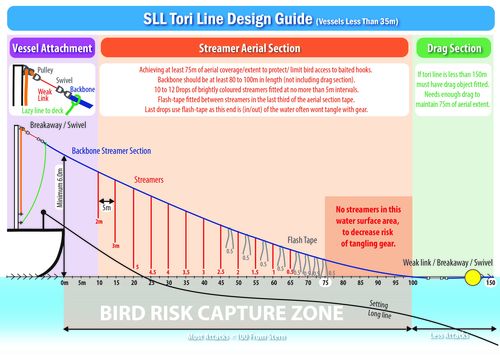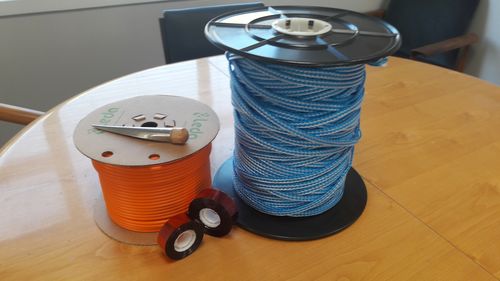New Programme Helping Save Seabirds
New Zealand’s surface longline fleet have been engaging in a new seabird liaison programme which aims to further reduce risks to seabirds.

Below: Tori line backbone (blue non-rotating rope), “flash-tape” (as used in horticulture to scare birds) and and orange streamer material.

The programme, funded and managed under the Department of Conservation’s Conservation Services Programme, provides materials, training and support to the fleet with Liaison Officers acting as the interface between industry, Government and researchers.
Liaison officers John Cleal and Gary Levy have been visiting the vessels, training their crews and developing risk management plans tailored to each vessel.
Both have previously worked in the fishing fleet, which is an advantage when training the crews because their lessons are practical and come from first-hand experience.
The liaison officers also come equipped with mitigation materials for each vessel such as tori lines, which have proven successful at reducing seabird captures in both longline and trawl fisheries.
Tori lines are brightly coloured streamers, and provide a physical and visual barrier detering birds from getting too close to the baited hooks.
Programme coordinator Richard Wells said the programme is off to a fast start.
“We started in December and by the end of February had a risk plan and tori materials on every boat, which was quite trying for the liaison officers over the Christmas period as they travelled to the far-flung ports these vessels are based in,” Wells said.
“We're now completing the second round of the programme, which involves reviewing the fleet’s performance to ensure these measures are fully understood and are being followed correctly. There is only one vessel we haven't visited at least twice and it will be in port in the next few weeks so we’ll be there to meet it.
“From our perspective it has gone very well, helped by having two liaison officers who know the fleet and how to deliver risk plans, as well as good support from the Department of Conservation and Ministry for Primary Industries.”
Department of Conservation’s Kris Ramm said he was happy with the initial roll-out.
“It’s been a great process and having the guys with a good strong industry knowledge really helps,” Ramm said.
“We are delivering materials to the fleet and not just showing up with abstract concepts, so in that sense it has been successful.”
New Zealand has signed up to the Agreement on the Conservation of Albatrosses and Petrels (ACAP) which came into effect in 2004 and this seabird liaison programme is one of the ways in which we are doing our part to reduce risks to these birds.
